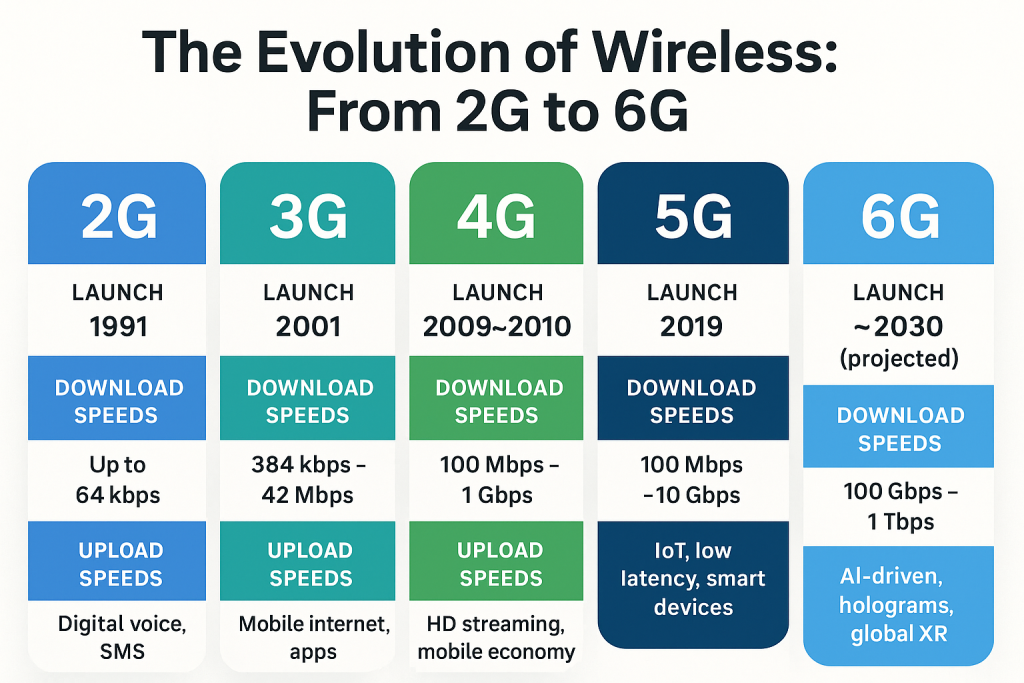
Wireless technology has transformed the way the world communicates, works, and innovates. Each generation of mobile connectivity has unlocked new capabilities, reshaping entire industries and fueling our digital lives. As we look ahead to 6G—expected around 2030—let’s take a detailed journey through the timeline of mobile evolution, from 2G to what’s coming next.
2G: The Birth of Digital Mobile (1991)
- Launch: 1991 (Finland, GSM standard)
- Speeds: Up to 64 kbps (with GPRS upgrades later reaching ~114 kbps)
- Key Breakthrough: Switched from analog to digital signals
- Impact: 2G introduced SMS text messaging, MMS, and more secure voice calls. It was the first step toward truly mobile data, albeit at dial-up-like speeds.
3G: Mobile Internet Arrives (2001)
- Launch: 2001 (Japan, NTT DoCoMo)
- Speeds:
- Initial: 384 kbps
- Later evolutions (HSPA+): Up to 42 Mbps download / 5.8 Mbps upload
- Key Breakthrough: Mobile broadband—email, web browsing, early video calling, and multimedia apps.
- Impact: Smartphones took off in the 3G era. The iPhone (2007) and Android devices thrived on 3G networks, setting the stage for today’s app-driven world.
4G / LTE: The Age of Streaming (2009–2010)
- Launch: First commercial LTE networks in 2009 (Stockholm & Oslo)
- Speeds:
- Theoretical: 100 Mbps download / 50 Mbps upload
- LTE-Advanced: Up to 1 Gbps download under ideal conditions
- Key Breakthrough: High-speed data enabling HD video streaming, mobile gaming, social media, and large file transfers.
- Impact: 4G was the engine of the mobile app economy. Uber, Netflix streaming, Instagram, and countless other data-heavy applications became possible.
5G: Ultra-Fast, Ultra-Low Latency (2019–2020)
- Launch: Initial rollouts in 2019, with wider adoption starting 2020
- Speeds:
- Typical: 100 Mbps – 10 Gbps download
- Upload: Typically 10–100 Mbps
- Key Breakthroughs:
- Ultra-low latency (~1 millisecond)
- Massive IoT support (millions of devices per square km)
- Network slicing for customized connectivity
- Impact: 5G is powering smart factories, autonomous vehicles, AR/VR, and ultra-reliable IoT applications. It’s not just about speed—it’s about enabling mission-critical communications.
6G: The Next Frontier (Projected ~2030)
- Expected Launch: Around 2030 (global standardization efforts are already underway)
- Projected Speeds:
- 100 Gbps – 1 Tbps download
- Upload speeds expected to be tens to hundreds of Gbps
- Key Innovations Anticipated:
- Sub-terahertz spectrum for blazing speeds
- Integration of AI into the network core for self-optimizing performance
- Extended reality (XR): seamless AR/VR/MR experiences at human-eye resolution
- Holographic communication and immersive telepresence
- Deep integration with satellites and non-terrestrial networks (NTN) for global coverage
- Impact: 6G aims to blur the line between the digital and physical worlds. Think real-time holograms for business meetings, AI-powered global IoT ecosystems, and lifelike metaverse applications.
Side-by-Side Evolution
| Generation | Launch Year | Download Speeds | Upload Speeds | Breakthrough |
|---|---|---|---|---|
| 2G | 1991 | Up to 64 kbps | ~14 kbps | Digital voice, SMS |
| 3G | 2001 | 384 kbps – 42 Mbps | Up to 5.8 Mbps | Mobile internet, apps |
| 4G | 2009 | 100 Mbps – 1 Gbps | 50 Mbps | HD streaming, mobile economy |
| 5G | 2019 | 100 Mbps – 10 Gbps | 10–100 Mbps | IoT, low latency, smart devices |
| 6G | ~2030 (projected) | 100 Gbps – 1 Tbps | 10s–100s of Gbps | AI-driven, holograms, global XR |
Final Thoughts
From text messages on 2G to the real-time holograms of 6G, every generation of mobile technology has fundamentally changed how we live, work, and connect. While 6G is still in development, the vision is clear: a future where the internet is instantaneous, immersive, and seamlessly integrated into everyday life.
At 6Gstore, we’ll continue to track this evolution—helping businesses and individuals understand, prepare for, and embrace the next wave of wireless innovation.